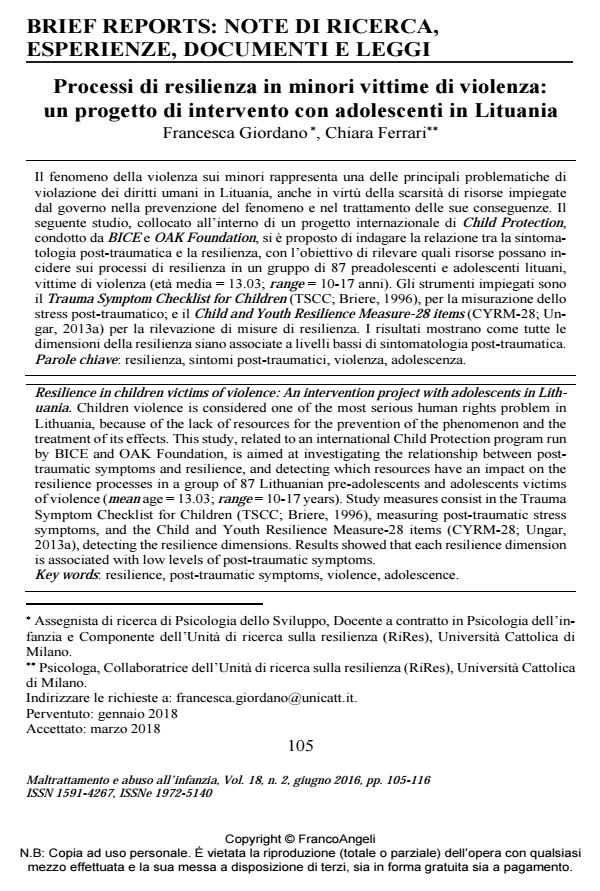Processi di resilienza in minori vittime di violenza: un progetto di intervento con adolescenti in Lituania
Titolo Rivista MALTRATTAMENTO E ABUSO ALL’INFANZIA
Autori/Curatori Francesca Giordano, Chiara Ferrari
Anno di pubblicazione 2018 Fascicolo 2018/2
Lingua Italiano Numero pagine 12 P. 105-116 Dimensione file 197 KB
DOI 10.3280/MAL2018-002007
Il DOI è il codice a barre della proprietà intellettuale: per saperne di più
clicca qui
Qui sotto puoi vedere in anteprima la prima pagina di questo articolo.
Se questo articolo ti interessa, lo puoi acquistare (e scaricare in formato pdf) seguendo le facili indicazioni per acquistare il download credit. Acquista Download Credits per scaricare questo Articolo in formato PDF

FrancoAngeli è membro della Publishers International Linking Association, Inc (PILA)associazione indipendente e non profit per facilitare (attraverso i servizi tecnologici implementati da CrossRef.org) l’accesso degli studiosi ai contenuti digitali nelle pubblicazioni professionali e scientifiche
Il fenomeno della violenza sui minori rappresenta una delle principali problematiche di violazione dei diritti umani in Lituania, anche in virtù della scarsità di risorse impiegate dal governo nella prevenzione del fenomeno e nel trattamento delle sue conseguenze. Il seguente studio, collocato all’interno di un progetto internazionale di Child Protection, condotto da BICE e OAK Foundation, si è proposto di indagare la relazione tra la sintomatologia post-traumatica e la resilienza, con l’obiettivo di rilevare quali risorse possano incidere sui processi di resilienza in un gruppo di 87 preadolescenti e adolescenti lituani, vittime di violenza (età media = 13.03; range = 10-17 anni). Gli strumenti impiegati sono il Trauma Symptom Checklist for Children (TSCC; Briere, 1996), per la misurazione dello stress post-traumatico; e il Child and Youth Resilience Measure-28 items (CYRM-28; Ungar, 2013a) per la rilevazione di misure di resilienza. I risultati mostrano come tutte le dimensioni della resilienza siano associate a livelli bassi di sintomatologia post-traumatica.
Parole chiave:Resilienza, sintomi post-traumatici, violenza, adolescenza.
- Running Away from the War in Ukraine: The Impact on Mental Health of Internally Displaced Persons (IDPs) and Refugees in Transit in Poland Damiano Rizzi, Giulia Ciuffo, Giulia Sandoli, Matteo Mangiagalli, Pietro de Angelis, Gioele Scavuzzo, Mariana Nych, Marta Landoni, Chiara Ionio, in International Journal of Environmental Research and Public Health /2022 pp.16439
DOI: 10.3390/ijerph192416439 - Esperienze Sfavorevoli Infantili: un Progetto in Campania per la prevenzione e l'intervento Giulia Savarese, Monica Romei, Luna Carpinelli, Daniela D’Elia, Rosa Angela Villani, Marianna Giordano, Annamaria Scapicchio, Domenico Costantino, in MALTRATTAMENTO E ABUSO ALL'INFANZIA 3/2021 pp.113
DOI: 10.3280/MAL2020-003009 - Child Psychological Adjustment to War and Displacement: A Discriminant Analysis of Resilience and Trauma in Syrian Refugee Children Guido Veronese, Alessandro Pepe, Francesca Giordano, in Journal of Child and Family Studies /2021 pp.2575
DOI: 10.1007/s10826-021-02067-2 - Resilience processes among Ukrainian youth preparing to build resilience with peers during the Ukraine-Russia war Francesca Giordano, Shannon Lipscomb, Philip Jefferies, Kyong-Ah Kwon, Marianna Giammarchi, in Frontiers in Psychology 1331886/2024
DOI: 10.3389/fpsyg.2024.1331886 - Tutor of Resilience: A Model for Psychosocial Care Following Experiences of Adversity Francesca Giordano, Alessandra Cipolla, Michael Ungar, in Frontiers in Psychiatry 559154/2021
DOI: 10.3389/fpsyt.2021.559154 - Building a coordinated response to prevent and respond to Adverse Childhood Experiences (ACEs) in Europe: The Tutor of Resilience program Francesca Giordano, Alessandra Cipolla, in MALTRATTAMENTO E ABUSO ALL'INFANZIA 1/2023 pp.33
DOI: 10.3280/MAL2023-001004 - Transit Migration and Trauma: the Detrimental Effect of Interpersonal Trauma on Syrian Children in Transit in Italy Francesca Giordano, Alessandra Cipolla, Fausto Ragnoli, Federico Brajda Bruno, in Psychological Injury and Law /2019 pp.76
DOI: 10.1007/s12207-019-09345-x - Testing Assisted Resilience Approach Therapy (ARAT) with children victims of violence F. Giordano, F. Ragnoli, F. Brajda Bruno, D. Boerchi, in Children and Youth Services Review /2019 pp.286
DOI: 10.1016/j.childyouth.2018.11.050 - Social-Ecological Resilience Moderates the Effectiveness of Avoidant Coping in Children Exposed to Adversity: An Exploratory Study in Lithuania Francesca Giordano, Simona C. S. Caravita, Philip Jefferies, in Frontiers in Psychology 536353/2020
DOI: 10.3389/fpsyg.2020.536353 - Data on resilience and trauma-related symptoms in Lithuanian children victims of violence F. Giordano, F. Ragnoli, F. Brajda Bruno, in Data in Brief 103791/2019 pp.103791
DOI: 10.1016/j.dib.2019.103791 - Principle-driven program design versus manualized programming in humanitarian settings F. Giordano, M. Ungar, in Child Abuse & Neglect 104862/2021 pp.104862
DOI: 10.1016/j.chiabu.2020.104862 - Building resilience for healthcare professionals working in an Italian red zone during the COVID‐19 outbreak: A pilot study Francesca Giordano, Alessandra Cipolla, Michael Ungar, in Stress and Health /2022 pp.234
DOI: 10.1002/smi.3085 - The Tutor of Resilience Program with Children Who Have Experienced Maltreatment: Mothers’ Involvement Matters F. Giordano, C. Taurelli Salimbeni, P. Jefferies, in Child Psychiatry & Human Development /2024 pp.295
DOI: 10.1007/s10578-022-01393-w
Francesca Giordano, Chiara Ferrari, Processi di resilienza in minori vittime di violenza: un progetto di intervento con adolescenti in Lituania in "MALTRATTAMENTO E ABUSO ALL’INFANZIA" 2/2018, pp 105-116, DOI: 10.3280/MAL2018-002007